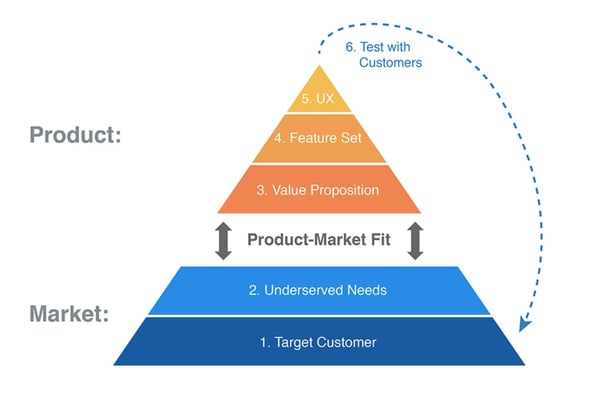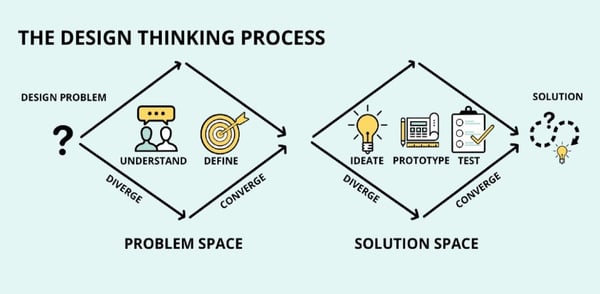Product/Market Fit, what is it?
The key to making your business work is to start by considering what your target customers want; that way, you can sell it to them.
For this reason, achieving a product/market fit is one of the most essential and initial goals for any business or startup needs to have.
The term “Product/Market Fit” (PMF, for short) is thought to have first been used by Marc Andreessen, co-founder of venture capital firm Andreessen Horowitz, in a 2007 blog post on startups. In it, he defined product/market fit as “being in a good market with a product that can satisfy that market.”
Josh Porter, co-founder of Rocket Insights, a product design agency, called product/market fit a magical moment when three things take place simultaneously:
- Users recognize your product’s/service’s benefit(s),
- They use word-of-mouth to share their positive experience with your product/service, and
- Your business contributes to a positive user experience.
If we break down these three aspects, we can say that to acquire a product/market fit, your team needs to bring three precise things together:
- The features you need to build or integrate into your product,
- The audience that will care about your product, and
- The business model (marketing and sales tactics) required to entice a customer to buy your product.
Achieving a product/market fit means that all three factors align.
Product/market fit is the initial stage of a business; it has successfully identified a customer base and provided them with the right product(s) to deliver significant value.
Ideally, you want to sell them something that works so well for them that they tell others about it. This word-of-mouth dynamic is especially crucial for newly established businesses.
An in-depth look at Product/Market Fit
To find the right PMF, entrepreneurs and product designers need to analyze their target market first.
While you may have specific ideas (including features, designs, and prototypes in mind), you want to ensure your end product will cater to a market that has a need for it.
Remember, you may be able to develop the best product in the world, but if it does not address a specific and essential need, it will likely not have success.
Once your team can prove a product/market fit, the next step is to scale by finding more customers within the target market.
Keep in mind – PMF refers to the specific market your solution caters to.
For example, if you are a software business launching a tool that combines marketing and sales solutions aimed at manufacturing companies, the specific market you are targeting is the CRM market and NOT the software or manufacturing sectors.
Product/market fit is a short-term success. Once you overcome the hurdle to obtain it, you will need to sustain it for your product’s long-term success.
Put simply, once a business attains a Product/Market Fit (PMF) for a specific product, it can assess:
- A market’s capability to sustain your business and
- Your product’s ability to meet that market’s needs.
The market your business should be targeting should be an expanding market, with increased demand for what you offer.
Without settling on a specific market, you are essentially hoping a specific client or audience uses your product and enjoys it. Not focusing on achieving a product/market fit before launching a product can lead to many losses, including losing time and money on a good that will not sale.
Obtaining a product/market fit can lead to many benefits including customers, clients, and brand ambassadors recommending the product to others on their own volition.
Steps to Achieving a Product/Market Fit
In his book, The Lean Product Playbook, product management expert Dan Olsen shares his knowledge and outlines the steps any business – regardless of the business model it uses – can attain the right product/market fit.
Olson called this process the Lean Product Process.
 (Source: Mind The Product)
(Source: Mind The Product)
The Lean Product Process
Attaining Product/Market Fit will require varying degrees of effort for each product or service you launch. It is not a standard process.
The Lean Product Process aims to clarify the pain point(s) you are trying to solve for your customer base and identify how big of a problem it is for them. If your audience does not care too much about the issue you want to resolve, then you might want to rethink your strategy.
Once you know you will be solving a problem worth clarifying, you will need to make sure your product can do so effectively.
Let’s examine the steps Olsen outlines in his process:
- Determine your ideal customer
The most crucial step is to select your target customer(s), as they will decide if your product meets their specific wants and needs.
To determine your ideal audience, you can use market segmentation, which will help you define the various characteristics, behaviors, and needs of your buyer personas.
Creating these “persona archetypes” will ensure that everyone on your team responsible for designing and building your product will know who to cater to and how to meet their needs. This is called the “customer hypothesis.”
With your newfound knowledge, you can make more educated decisions around your product’s detail and the best way to market it.
- Identify undeserved Customer Needs
Once you have structured your customer hypothesis, you will then need to understand their undeserved needs.
What do we mean by that?
By undeserved needs, we refer to the specific needs (or problems) that bring in new market opportunities and that are currently not met.
For example, a business in the human food processing industry could take advantage of the growing trend toward healthy nuts and dried fruit consumption. It could add a diverse array of low-fat, low calorie, or no sugar added nuts and fruits at a low price, something its direct competitors are currently not producing.
The idea is to identify the specific needs of your customer base that translate into viable market opportunities. You will want to address the customer needs that are currently not met to provide real value to your future customers.
To achieve this, to use the “problem space” vs. “solution space” strategy. The goal of this approach is to gain a middle ground.
The problem space will help your team determine your customers’ problems, such as what is lacking in competitors’ products that are similar to your own.
The solution space will help your product team find new ideas to address these problems. The information you place into the solution space will give you a better idea of which features you will need to add to address this and stand out.
 (Source: Medium)
(Source: Medium)
Once your product time has gathered this data, you will be in a better position to lay out the objectives of your marketing plan.
- Define your unique Value Proposition
Once you have identified your customers’ problems and their possible solution(s), you will need to determine your value proposition.
The value proposition is how your product will solve your customers’ needs; it is the promise of the benefits you will deliver.
For example, Slack’s value proposition is to allow work teams to be more productive in their work with less effort. Uber’s value proposition is to provide accessible, low-cost car rides, 24/7.
At its core, a value proposition outlines a proposal for how a specific product will meet customers’ needs in a better way than its direct competitors.
To go about this, choose which consumer pain points your product does a great job of resolving. Determine which product features will attract customers and how your product differentiates from those of direct competitors.
- Understand your Minimum Viable Product features
After you have specified your unique value proposition, the next step is to determine your minimum viable product (MVP).
An MVP specifies the basic features your product needs to have to achieve maximum growth in its respective market. In other words, your team should have a clear idea of the first things your product requires for your target customers to be excited about it.
To pinpoint your product’s MVP and increase its overall ROI once it is in the market, your product team will need to group your basic features into four categories:
- Functionality
- Reliability
- Usability
- Delightfulness
A product whose characteristics fall within the categories above is more likely to be regarded as higher value. Before testing your product on consumers, make sure its features make it functional, problem-oriented, and easy to use.
Keep in mind – the work required for this step aims to ensure your team creates a product that is not over the top. You want to identify the least number of features your good requires to be validated by its target consumer.
Once you know this, you will have more freedom to work out the rest of your product’s details like the unique feature that will make it stand out in its market.
- Design your Minimum Viable Product Prototype
Now that you have identified the elemental features a product needs to be successful in its market, your product team will need to create a prototype before it can build the actual product.
Tools like InVision and Figma are useful when creating a digital prototype and can help simulate the final product so that users can test it.
 (Source: Medium)
(Source: Medium)
- Evaluate your Minimum Viable Product
Once you have your prototype, ask for your target market's honest feedback.
To ensure you are soliciting the opinions of your target market, apply a short survey or one-on-one interviews to determine if each individual falls within your requirements. The last thing you want is to invest time and other resources testing consumers who will not use your product once it is in the market.
Consumers’ observations should include whether the product will fit their needs, solve their pain point(s), and any improvements that may be necessary.
In this step, you want to evaluate whether your product is on the right track to instilling confidence and trust in your target consumers. If consumers’ feedback does not 100% lead to this conclusion, you may need to make some changes to your customer hypothesis or your MVP.
Start Improving your Product/Market Fit Today
If your business is working on a new product/service or in the past the product/service you launched was not the success you expected, chances are you might have skipped out on any one of the steps in the Lean Process Method.
The Lean Process Method works. When you follow it step-by-step and modify the processes to fit your company’s needs, your team is more likely to build and launch a successful product that delights its target consumers.




